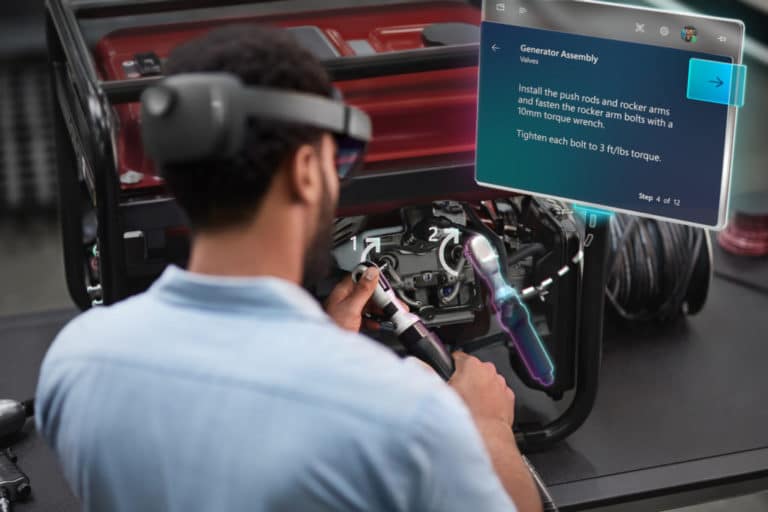
Mixed reality (MR) is a cutting-edge technology that blends the physical and digital worlds. It combines virtual reality (VR) and augmented reality (AR) elements, creating an immersive environment where real-world and virtual objects interact. This innovation is becoming increasingly relevant in the manufacturing sector.
Manufacturers are adopting MR to enhance various aspects of their operations, especially safety. The integration can simulate complex processes, train employees safely, and identify potential hazards without the risks associated with real-world trials. This trend significantly shifts toward more interactive and technologically advanced manufacturing practices.
Understanding Mixed Reality in Manufacturing
In the manufacturing sector, MR technology is rapidly evolving. Industry professionals use it for various applications, from design and prototyping to training and maintenance. Features that benefit manufacturing include the following:
- Real-time collaboration: MR allows for more effective cooperation among teams, including remote assistance and shared visualizations of projects.
- Enhanced training: It provides realistic, interactive training environments, enabling workers to practice complex tasks in a safe, controlled setting.
- Hazard simulation: MR can simulate potential workplace hazards, allowing for better preparedness and risk assessment without exposing workers to actual danger.
Further, the broader context of MR in the digital world is noteworthy. According to a survey, 54% of experts believed the metaverse would be a functioning aspect of the lives of more than half a billion people by 2040. It’s a collective virtual space with virtually enhanced physical and digital reality.
This prediction underscored the potential for MR technology to revolutionize manufacturing and become a significant part of society soon. The integration of MR into manufacturing indicates a future where the lines between physical and digital realities become increasingly blurred.
Real-World Applications of MR for Safety
MR is significantly impacting the manufacturing industry with various practical applications:
- Boeing’s use of HoloLens for wiring: The company employs MR to assist technicians in airplane wiring. They boost accuracy and speed by 33% using headsets that let technicians see the wiring layout overlayed on the aircraft.
- Automotive design and prototyping: In the automotive industry, manufacturers use MR for designing and prototyping vehicles. It allows designers to visualize and manipulate car models in 3D, streamlining the design process and reducing the need for physical prototypes.
The technological innovation is also transformative in terms of safety:
- Identifying potential hazards: MR can simulate manufacturing environments, enabling safety officers to identify potential risks and dangers. By visualizing these threats in a virtual setting, companies can take preemptive measures to mitigate them.
- Training for complex tasks: MR provides a safe platform for training employees in complex and potentially dangerous tasks. For example, workers can practice operating heavy machinery in a controlled environment, gaining experience and confidence before handling actual equipment. This reduces the risk of accidents and injuries during operations.
MR’s capability to blend real-world scenarios with simulations offers a safer and more efficient approach to manufacturing. It enhances the quality and precision of tasks, and maintains a high workplace safety standard.
Benefits of Mixed Reality for Safety Management
MR streamlines manufacturing processes, leading to greater efficiency. For instance, real-time data visualization and interactive 3D models help in quicker decision-making and problem-solving. This efficiency saves time and reduces the risk of errors that could lead to accidents.
Moreover, while the initial investment in MR technology can be significant, it reduces training costs by replacing physical prototypes and setups with virtual simulations. Additionally, minimizing accidents and improving efficiency can lower insurance costs and downtime, ultimately saving money for the company.
This technology enhances compliance with safety regulations. For example, the Occupational Safety and Health Administration made significant amendments in 2012 to the Hazard Communication Standard, aiming to standardize the criteria for hazard classification. MR can be instrumental in training employees on these regulations. It allows immersive training sessions where workers can learn about hazard communication in a controlled, interactive environment, ensuring better understanding and adherence to safety standards.
Challenges and Considerations
Implementing MR in manufacturing — while beneficial — comes with challenges:
- Technological limitations: MR technology is still evolving. Issues like battery life, the need for robust processing power, and potential technical glitches can hinder its seamless integration into manufacturing processes.
- Workforce training and adaptation: Successfully implementing MR requires a workforce trained and comfortable with the technology. It involves understanding how to use MR devices and adapting to a new working method. The shift from traditional approaches to high-tech solutions can be challenging for some employees.
- Privacy and data security concerns: As with any technology that processes and stores data, MR raises concerns about privacy and data security. Data breaches are a risk due to the digitalization of manufacturing processes and sensitive information. Considering it takes an average of 277 days to resolve a data breach, it’s a significant concern. Companies must ensure robust cybersecurity measures are in place to protect confidential information.
Future of Mixed Reality in Manufacturing Safety
The MR market — growing at an impressive 78% annually — can significantly impact manufacturing. Future trends include advanced integration with artificial intelligence and the Internet of Things, leading to smarter, more intuitive MR systems, improved hardware, and customized applications for specific manufacturing needs.
These advancements will enhance efficiency in manufacturing, particularly in safety training and real-time hazard detection. Integrating MR with real-time analytics and predictive maintenance will also transform decision-making processes in manufacturing.
Embracing MR for Safety and Efficiency
Adopting new technologies like mixed reality creates a safer and more efficient work environment. As it continues to evolve, it brings transformative solutions that enhance safety protocols and streamline manufacturing.
Additionally, staying informed about the latest developments in MR technology is crucial for anyone involved in manufacturing. As technology rapidly advances, keeping up-to-date ensures practices remain cutting-edge and competitive.
 Devin Partida is Editor-in-Chief of Rehack and editorial contributor at AR Insider. See her work here and follow her @rehackmagazine.
Devin Partida is Editor-in-Chief of Rehack and editorial contributor at AR Insider. See her work here and follow her @rehackmagazine.






